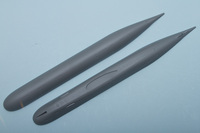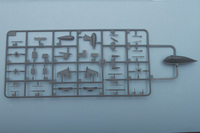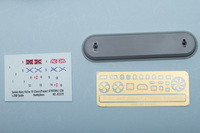Overview
The Project 671 submarine (NATO codename: Victor) was the replacement for the Projectt 627 (November) in the Soviet Navy. The first ship in its class entered service around 1967, and it featured a teardrop hull shape that improved its speed underwater. The early Victors were still noisy boats, though, and the Russians attempted to rectify that with the 671RTM (Victor III), which was longer and quieter than the original Victor I. The Victor III first entered service in 1979, and the type remained in production until 1991.
The 671RTMK was a further improvement over the 671RTM, with the addition of improved computer systems. The Russians acquired a Norwegian navy software program and computer systems from Toshiba that resulted in a superior integrated combat system. The 671RTMK also added the non-acoustic sensor system designed for the 971 (NATO codename Akula) submarine.
The Kit
 The Hobby Boss 1/350 Victor III kit is another welcome addition to the recent growing interest in 1/350 injection molded submarine kits. Molded in the usual Hobby Boss gray plastic, this kit features petite recessed details on the hull and several options. In addition to the plastic parts, the kit comes with a small fret of photoetch that provides some of the finer detailing. The small decal sheet offers up the minimal markings found on modern submarines.
The Hobby Boss 1/350 Victor III kit is another welcome addition to the recent growing interest in 1/350 injection molded submarine kits. Molded in the usual Hobby Boss gray plastic, this kit features petite recessed details on the hull and several options. In addition to the plastic parts, the kit comes with a small fret of photoetch that provides some of the finer detailing. The small decal sheet offers up the minimal markings found on modern submarines.
Construction begins with the main hull, and this is split into separate upper and lower halves. Both the upper and lower hull pieces feature fine details molded in place, including the various vents on the bottom of the hull. The sail is separate, and a quick test shows that with just a bit of cleanup work, it will fit seamlessly into the upper hull. There are all the options for the antennae and periscopes, so the top of your sail can be quite busy. The photoetch provides the cover hatches for all of these bits, as well as the bridge windscreen. The windows are solid in this piece, though, so this part is probably best replaced by some thin clear stock, carefully masked and painted.
 Moving to the rear of the sub, there are two screw options provided. The first on has two four-bladed screws mounted on a single shaft, while the other option has the sickle-blade seven-bladed screw. In both cases there is an option to use plastic parts or use photoetch blades. Given the scale, the photoetch blades are the better option, but they will require some careful bending and twisting to get them in the right shape.
Moving to the rear of the sub, there are two screw options provided. The first on has two four-bladed screws mounted on a single shaft, while the other option has the sickle-blade seven-bladed screw. In both cases there is an option to use plastic parts or use photoetch blades. Given the scale, the photoetch blades are the better option, but they will require some careful bending and twisting to get them in the right shape.
With the sail in place and the screw on, the remaining bits are just the details. All four fins are separate, and also feature separate rudders. The forward dive planes are also separate, and you have the option of displaying those extended or retracted. There are two scoops for the lower rear hull, and finally the torpedo loading hatch on the bow is provided as a separate piece.
 Painting the Victor III is easy, as you can paint it any color, as long as it's black. There are some small details that will add a bit of life to the model, but really, this is one that will rely on weathering to break up the monotony of the single color. The decal sheet provides the various level marks and a handful of hatch outlines, but interestingly it does not provide the white outlines to the torpedo tube openings. It does provide two styles of Russian Navy flags, though, for that added extra bit of flash.
Painting the Victor III is easy, as you can paint it any color, as long as it's black. There are some small details that will add a bit of life to the model, but really, this is one that will rely on weathering to break up the monotony of the single color. The decal sheet provides the various level marks and a handful of hatch outlines, but interestingly it does not provide the white outlines to the torpedo tube openings. It does provide two styles of Russian Navy flags, though, for that added extra bit of flash.
Conclusion
This is a great kit out of the box, with only a few bits needing improvement. The breakdown of the kit, even with the photoetch, is simple enough to make this a fun weekend project. My thanks to Squadron for the review sample.